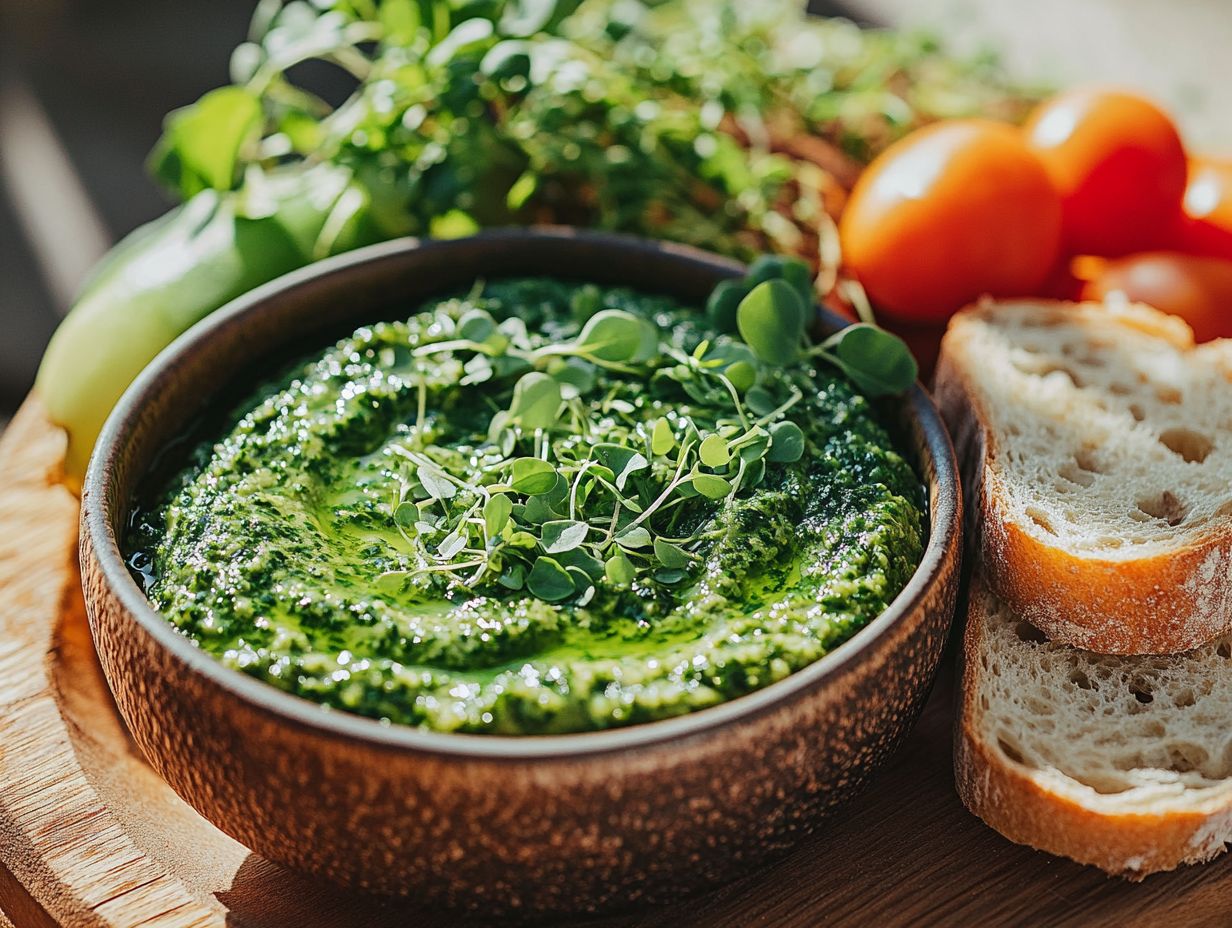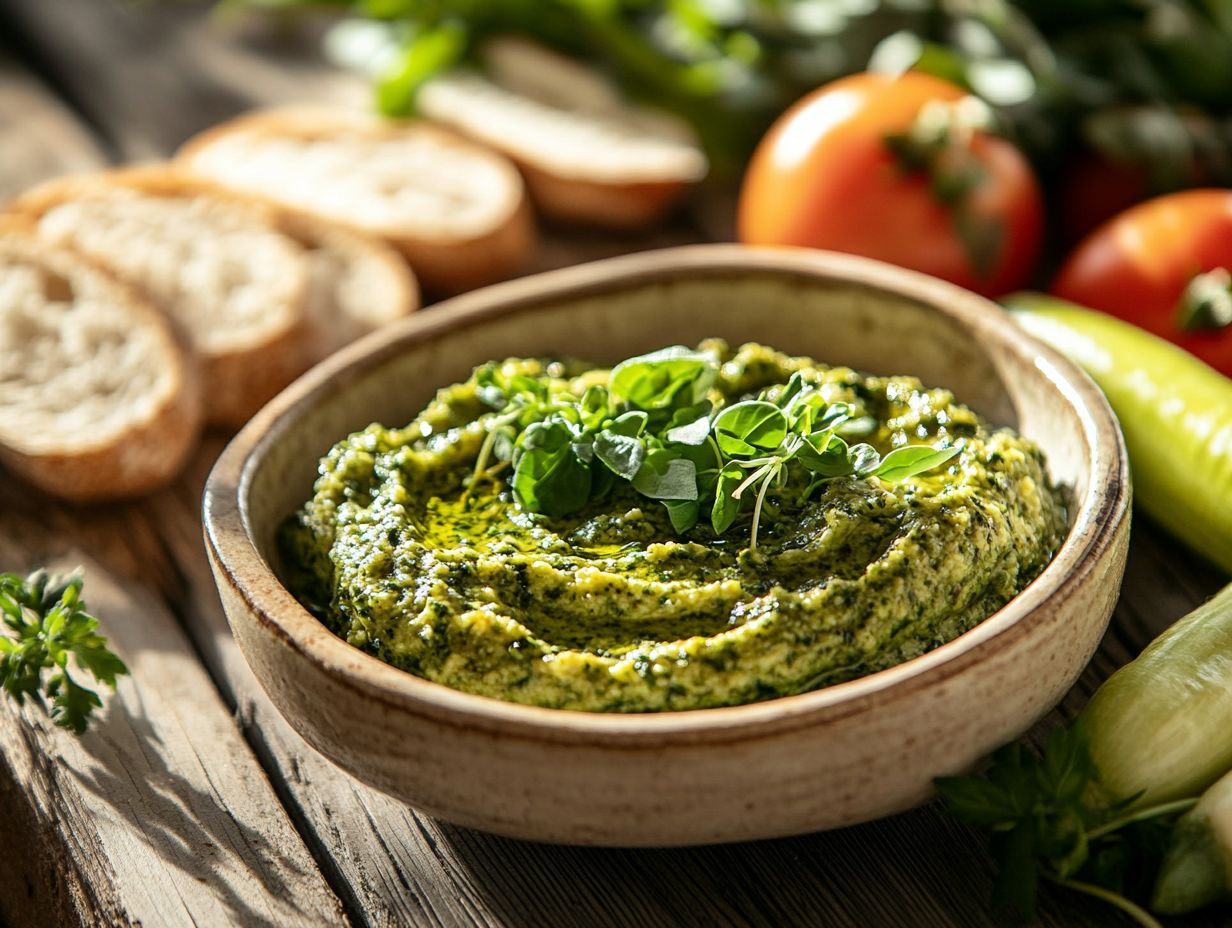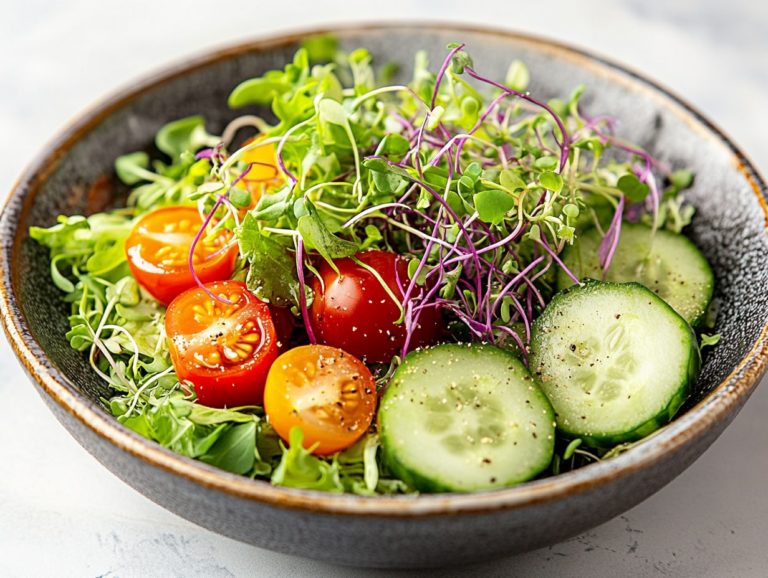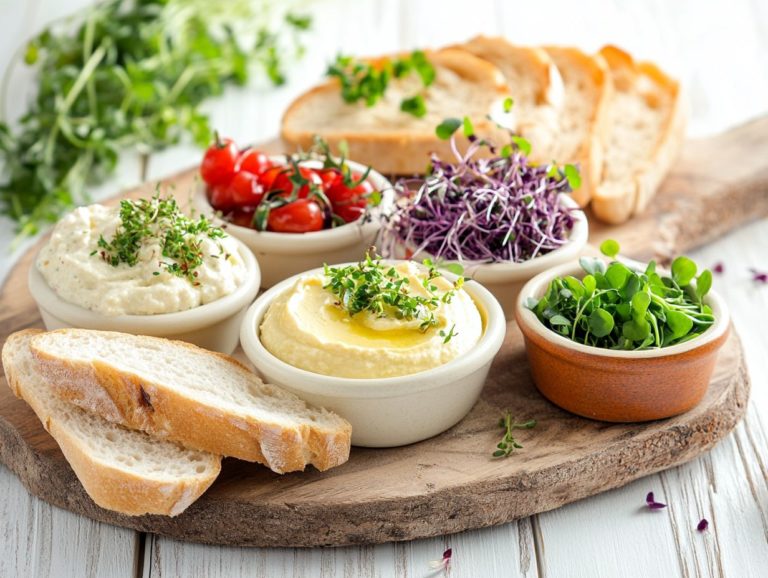21. Microgreen Tapenade: A Unique Spread
Microgreens are tiny powerhouses of flavor and nutrition! These small, nutrient-rich plants have gained a strong following in the culinary scene. Their vibrant flavors and impressive health benefits make them fantastic ingredients for a diverse array of dishes.
This article invites you to explore the creation of a delectable microgreen tapenade, showcasing its nutritional value and versatile applications. Get ready to discover a unique spread that is as flavorful as it is nutritious!
Whether you aim to elevate appetizers or introduce a refreshing twist to your meals, you’ll uncover tips for growing your own microgreens right at home.
Contents
Key Takeaways:
Here are the key takeaways from this article:
- Discover the world of microgreens and their unique flavor and health benefits.
- Learn how to make a delicious and nutritious microgreen tapenade using simple ingredients and easy preparation steps.
- Explore the versatility of microgreen tapenade with creative recipe ideas, and learn how to grow your own microgreens at home with our step-by-step guide.
What are Microgreens?
Microgreens are those delightful young plants you see just after the first true leaves peek out, usually only a few inches tall. These vibrant greens don’t just bring a splash of color and texture to your dishes; they also deliver an impressive burst of flavor and nutritional goodness.
Rich in vitamins and antioxidants, microgreens can elevate your meals and snacks, making them a staple in modern culinary practices, especially within Mediterranean-inspired cuisine. For creative ideas, check out these microgreens snack platter ideas where fresh flavors reign supreme.
You’ll find a wide variety of microgreens at your disposal, such as arugula, radish, basil, and kale. Each boasts its own unique flavor profile that can enhance everything from gourmet salads to artisanal sandwiches.
Packed with essential nutrients, these petite greens can contain up to 40 times more vitamins than their fully grown counterparts, making them a powerhouse addition to any health-conscious diet.
Often used as garnishes or key ingredients in sauces and dips, microgreens not only enhance the visual appeal of your plates but also enrich the overall depth of flavor in your entrees and side dishes. For those looking to elevate their culinary skills, exploring best recipes with microgreens makes them a favorite among both chefs and home cooks.
How to Make Microgreen Tapenade
Crafting a delectable microgreen tapenade is a straightforward endeavor that showcases the vibrant freshness of microgreens. This versatile spread elevates an array of dishes and serves as an exquisite appetizer or a delightful addition to your cooking options.
Drawing inspiration from Mediterranean cuisine, this recipe is quick to prepare and relies on simple pantry staples. You’ll effortlessly elevate your charcuterie board a platter of meats and cheeses or holiday spread with a savory touch that impresses in no time.
Ingredients and Preparation
To create the perfect microgreen tapenade, gather fresh ingredients like garlic, lemon juice, olive oil, capers, and a vibrant selection of microgreens. Each of these elements plays a crucial role in achieving the exquisite flavor profile you desire.
Microgreens, whether you opt for basil, arugula, or radish greens, introduce vibrant flavors alongside a wealth of nutrients, including antioxidants and essential vitamins. For a fun twist, try out these microgreen dips for entertaining.
The garlic provides a compelling aroma and boasts antimicrobial properties. Meanwhile, the olive oil adds heart-healthy fats that support cardiovascular wellness. The tangy notes of fresh lemon juice elevate your dish, delivering a burst of vitamin C that bolsters immunity. Capers offer a salty, briny kick, enriching this savory spread. For an exciting twist, consider trying delicious microgreen tapas for sharing.
Together, these ingredients create a harmonious blend that tantalizes your taste buds and aligns with your wellness goals. With the right proportions and a touch of care in preparation, crafting this gourmet tapenade transforms into an enjoyable culinary adventure that you won’t want to miss. To elevate your dishes further, consider adding microgreens for a flavor boost.
Benefits of Microgreen Tapenade

Microgreen tapenade isn t merely a delightful enhancement to your meals; it s also a treasure trove of health benefits thanks to its impressive nutritional profile. Bursting with vitamins, minerals, and antioxidants from microgreens and fresh herbs, this spread not only supports your overall well-being but also elevates your cooking experiences.
For those who prioritize health without compromising on flavor, don t miss out on trying this it’s a game changer!
Nutritional Value and Health Benefits
The nutritional value of microgreens is nothing short of remarkable; they can deliver up to 40 times more nutrients than their mature counterparts, offering a significant health boost with every bite.
These tiny greens are rich in essential minerals like calcium, magnesium, and iron crucial for maintaining strong bones and ensuring efficient oxygen transport throughout your body.
The antioxidants found in microgreens, such as quercetin and kaempferol, are substances that help fight damage in your body. They work diligently to neutralize free radicals, potentially reducing inflammation and lowering the risk of chronic diseases.
By incorporating a variety of microgreens into your meals, you not only enhance your diet but also improve your health. They are an excellent choice for anyone seeking to enrich their nutritional intake while enjoying vibrant flavors.
With such a concentrated source of nutrients packed into these petite greens, it s easy to see why they re becoming the star players in health-conscious kitchens everywhere.
Ways to Use Microgreen Tapenade
Microgreen tapenade opens the door to a world of culinary possibilities. It s an exceptional choice for a variety of dishes and occasions, ranging from laid-back snacks to sophisticated appetizers.
This versatile spread complements crispy crostini perfectly, enhances creamy cheeses with a burst of flavor, and elevates your charcuterie board with rich textures and vibrant colors.
Creative and Delicious Recipes
There are countless ways for you to savor microgreen tapenade, especially within the vibrant realm of Mediterranean cuisine, where fresh, bold flavors truly shine. Whether you’re crafting simple summer appetizers or diving into more intricate dishes, this adaptable spread can easily be tailored to suit your palate.
It pairs beautifully with various seasonal ingredients, transforming every meal into a delicious affair and serving as a stunning centerpiece for gatherings. Imagine pairing it with grilled peaches and creamy burrata for a refreshing summer salad, or incorporating it into a savory tart filled with tangy goat cheese and seasonal vegetables.
Whether you choose to slather it on crusty bread or serve it alongside roasted meats, its adaptability truly stands out. The allure of microgreen tapenade lies in its remarkable ability to elevate everyday dishes into something extraordinary, inviting you to explore a world of flavors while basking in the freshness it brings. For an adventurous twist, consider microgreens in desserts, showcasing unusual combinations that can surprise your palate.
Tips for Growing Your Own Microgreens

Growing your own microgreens is not just a gardening task; it s an enriching experience that allows you to savor fresh, nutrient-rich greens right from the comfort of your home. This delightful endeavor enhances your meals and fosters healthier eating habits.
With a few straightforward steps and some essential supplies, you can cultivate an array of microgreens, whether indoors or outdoors. It’s a rewarding journey, perfectly suited for both seasoned gardeners and enthusiastic beginners alike.
Try adding microgreen tapenade to your next dish for an instant flavor upgrade!
Step-by-Step Guide to Growing Microgreens at Home
To successfully grow microgreens at home, start with quality seeds, the right soil, and a well-ventilated space that enjoys ample light whether from the sun or artificial sources. The process is simple: plant the seeds, manage watering and light conditions carefully, and harvest them at the best moment to maximize flavor and nutrition.
In the early stages, choosing high-quality seeds is crucial. Opt for organic varieties known for their germination rates and taste. Pair these seeds with nutrient-rich soil that retains moisture while allowing for drainage to prevent root rot.
For watering, consistency is key. Aim for a light misting daily, adjusting based on the humidity in your environment. Lighting is vital; a south-facing window or grow lights can ensure your seedlings receive at least 12-16 hours of light each day.
As your microgreens grow, monitor their development closely to identify the best time to harvest, usually when they reach about 1-2 inches in height. Be careful about common challenges like mold, which can occur in overly damp conditions. Ensure good air circulation and avoid overwatering to cultivate a healthy, thriving yield.
Final Thoughts and Recommendations
Microgreen tapenade is a delicious and versatile spread you ll love! It brings a host of health benefits that can elevate your culinary experiences. Whether you’re enhancing your appetizer spreads or exploring new flavors, incorporating microgreens into your diet opens up a world of exciting and nutritious meals that will delight your palate.
“`html
By blending these tiny greens with olives, nuts, and herbs, you can create a vibrant, nutrient-packed dish that bursts with flavor. This tapenade isn’t just a lovely addition to crackers and bread; it can transform pasta dishes and salads into gourmet experiences. For more ideas, explore microgreen toppings that offer antioxidant properties to boost your immunity and support overall well-being.
“`html
Don’t hesitate to experiment with different varieties; perhaps add a splash of citrus or a dash of spices. Share your unique creations with friends and family; their feedback might just spark your next culinary masterpiece. Don’t wait! Try making microgreen tapenade today and elevate your meals!
“`
Frequently Asked Questions
What are microgreens and how are they used in tapenade?

Microgreens are young and small leafy vegetables harvested after the first true leaves develop. They are often used as a garnish or to add flavor and texture to dishes, including tapenade.
What makes microgreen tapenade unique?
Microgreen tapenade is unique because it uses microgreens instead of traditional herbs like basil or parsley. This gives the spread a fresh, vibrant flavor and adds a nutritional boost.
What are the health benefits of microgreens in tapenade?
Microgreens are packed with nutrients, including vitamins, minerals, and antioxidants. They also contain high levels of enzymes, which aid digestion and support overall health and well-being.
Can microgreen tapenade be made with any type of microgreens?
Yes, microgreen tapenade can be made with various microgreens, such as arugula, kale, broccoli, or pea shoots. Experiment with different combinations to find your favorite flavor profile.
How can microgreen tapenade be used?
Microgreen tapenade can be spread on sandwiches or crackers, used as a dip for vegetables or pita chips, or as a topping for grilled meats or fish. It can also be mixed into pasta or grain dishes for added flavor and nutrition.
Is microgreen tapenade easy to make at home?
Yes, microgreen tapenade is easy to make at home. Simply pulse together microgreens, olives, capers, garlic, and olive oil in a food processor until a paste-like consistency is achieved. Add your choice of seasonings and enjoy!






